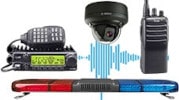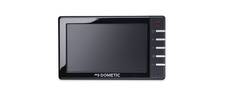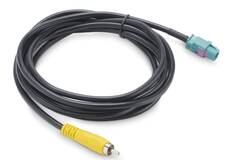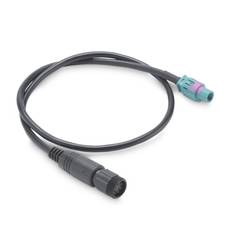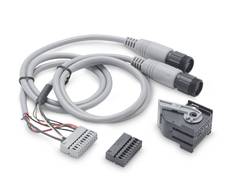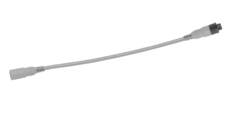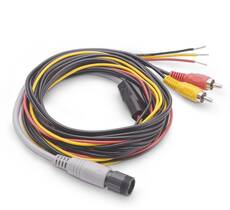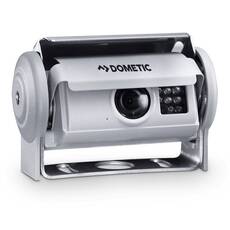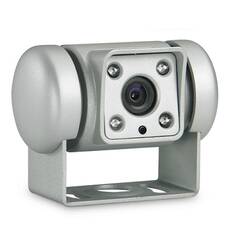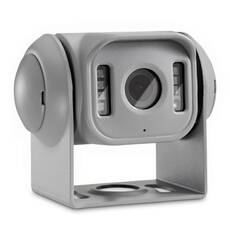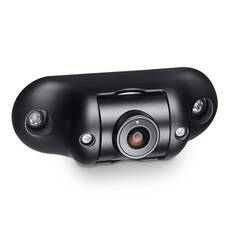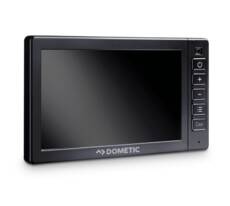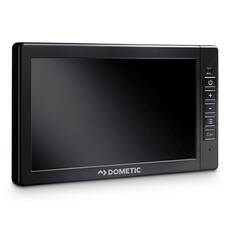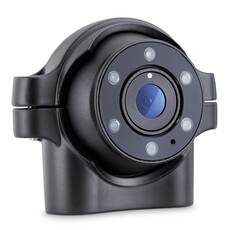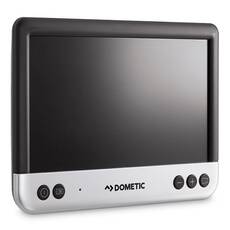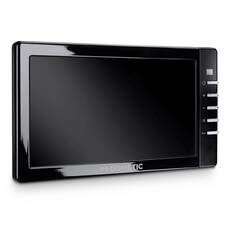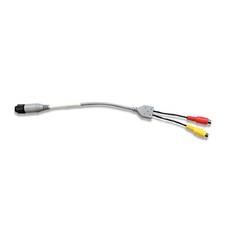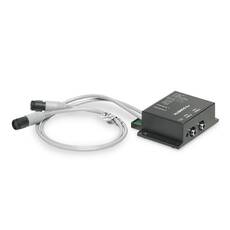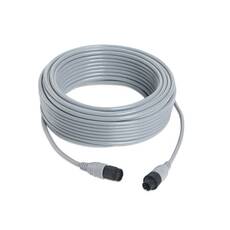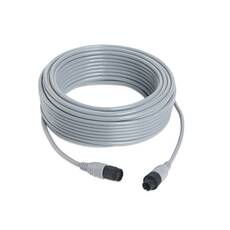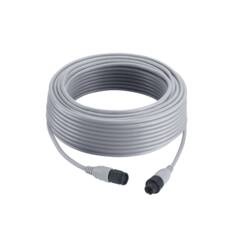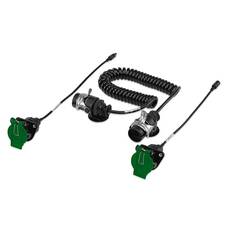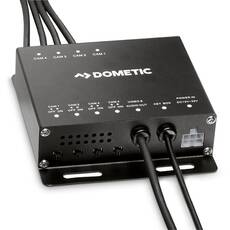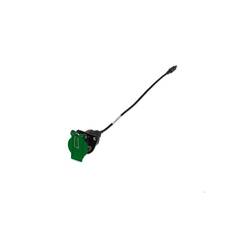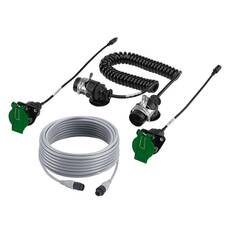Rear View System
Nowadays, the use of a reversing camera is no longer an unnecessary luxury. In fact, nowadays it can even pay for itself without the first parking accident. Because of its usefulness, this convenience feature is now standard in many new cars and can be retrofitted to older models, even by the driver. Read more...
• 5" LCD monitor
• Energy-saving LED back-lighting for excellent image quality
• Up to three cameras can be connected
• Temperature-controled heater
• Great image quality in all light conditions
• Normal or mirrored picture function
• Input voltage (DC) 12/24V
• Auto dimmer function (brightness controling)
• Adapter for connecting Dometic PerfectView cameras to the original multimedia display in certain MAN TG3 trucks
• For connecting Dometic PerfectView rear cameras to the multimedia display
• Suitable for MAN TG3 MMT multimedia systems with video preparation 0P2D0, 0P2D1, 0P2D2 and 0P2D3
• Compatible with Dometic PerfectView CAM 29SX, CAM 60ADR, CAM 80CM, CAM 301 camera models
• Product color: black
• Product dimensions: 14 mm (depth) x 14 mm (height) x 150 mm (width)
• Net weight: 0.10 kg
• Easy connection of the Dometic PerfectView CAM 55 heavy-duty camera to the MMT multimedia system
• Connects to MAN TG3 MMT multimedia systems with video pre-production 0P2D0, 0P2D1, 0P2D2 and 0P2D3
• Dimensions: 14 mm (depth) x 14 mm (height) x 150 mm (width)
• Net weight: 0.10 kg
• Cost-saving solution - no separate control box required
• Camera/display cable for Mercedes-Benz Actros 5
• Compatible for connecting the Dometic PerfectView CAM55 reversing camera to the multimedia display
• Custom fit for J6B/J6C multimedia systems with J9P video preparation on Mercedes Actros 5 and Antos trucks
• Heavy duty adapter
• Dimensions: 14 mm (depth) x 14 mm (height) x 150 mm (width)
Special gross price: 52.50€ (Net price: 41.34€)
• 6-pin DIN black cable, fits WAECO CRT systems manufactured before 2009
• Plug and play system upgrade
• No need to lay new cables when replacing older cameras
• Connects the old camera to the new monitor
• Product color: gray
• Product dimensions: 14 mm (depth) x 14 mm (height) x 150 mm (width)
• Weight: 0.1 kg
• For connecting Dometic PerfectView reversing cameras to non-Dometic multimedia displays and navigation systems with RCA input
• Universal adapter
• Compatible with Dometic PerfectView camera models, except for roller shutter cameras
• Weight: 0.08 kg
• Dimensions: 215 mm x 40 mm x 121 mm
• Very compact high-resolution shutter camera - the smallest on the market!
• 120° wide angle lens with wide angle of view
• LED support for high contrast night images
• Built-in microphone to hear what's going on around the vehicle
• Input voltage (DC): 12 V
• Colour: silver
• Dimensions: 54 mm (depth) x 68 mm (height) x 106 mm (width) x 0.4 kg
• Input voltage (DC): 12V
• 12V (input voltage 12V)
• Separate infrared LEDs for optimal night vision
• Temperature-controlled heater for use in cold climates
• Integrated microphone
• Normal or mirrored image function
• Ready for connection to navigation systems
• IP 69K protection
• Dimensions: 50 mm (depth) x 60 mm (height) x 78 mm (width) x 0.20 kg
• Heavy-duty colour camera, silver, 120° diagonal
• Robust and tight aluminium housing
• Input voltage (DC): 12/24 V
• Connectable to OEM multimedia systems and ISO bus terminals with vehicle specific adapter
• Separately positioned LEDs for glare-free vision day and night
• Dimensions: 62 mm (depth) x 50 mm (height) x 80 mm (width) x 0.25 kg
• Input voltage (DC): 12V
• Dimensions: 29 mm (depth) x 33 mm (height) x 76 mm (width) x 0.04 kg
• Unique solution for vans - ideal for tricky installation conditions
• Wide angle lens with wide field of view (150° diagonal)
• IP68 water resistance
• Colour cylindrical camera (NTSC) with 1/4" CMOS image sensor
• Factory preset mirror function to provide a familiar rear-view mirror image
• High light sensitivity for sharp, high contrast images
• Electronic brightness adjustment for consistently good image quality
• PerfectView M 55LX AHD heavy-duty 5-inch LCD monitor with AHD technology
• Digital LCD technology with LED backlighting and analog high-definition (AHD) imaging provides excellent image quality, day and night
• Image settings can be saved separately for each camera input
• Adjustable distance markers define the danger zone for safe reversing
• Four cameras can be connected, with a signal recognizer to activate the side camera indicator light
• Product dimensions: 26 mm (depth) x 87 mm (height) x 148 mm (width)
• Weight: 0.35 kg
• Heavy-duty 7" LCD monitor with AHD technology
• Input voltage (DC): 12/24 V
• Four cameras can be connected
• Image settings can be saved separately for each camera input
• Automatic trailer camera detection
• Attachable sunshield for glare-free viewing
• Optional mirror function provides a familiar rearview mirror view
• Adjustable distance markings define danger zone for safe reversing
• Dimensions: 26 mm (depth) x 110 mm (height) x 190 mm (width) x 0.4 kg
• Input voltage (DC): 12 V
• Compact design - easy to adjust
• Spherical camera with flexible mounting options
• Stable aluminium housing
• Waterproof and corrosion-resistant design
• Infrared LEDs support wide angle lens - perfect image quality
• Dimensions: 44 mm (depth) x 84 mm (height) x 58 mm (width) x 0.14 kg
• Small colour shutter camera, silver, 145° viewing angle, PAL video signal
• Very compact design - the smallest shutter camera on the market
• 145° wide angle lens with wide angle of view
• Automatic motorised cover protects the lens from dust and stones
• Temperature-controlled heating
• Built-in microphone
• LED support for high contrast images at night
• Mirror image function can be set to get the familiar rear-view mirror image
• Input voltage (DC): 12V
• Dimensions 54 mm (depth) x 68 mm (height) x 106 mm (width) x 0.4 kg
• LED-backlit digital LCD technology ensures excellent picture quality
• Automatic dimmer function increases comfort and convenience
• Four camera inputs, three of which can be activated by external signals
• Image settings can be saved separately for each camera input
• Optional mirror function provides a familiar rearview mirror image
• Input voltage (DC): 12/24 V
• Weight: 0,93 kg
• Digital 7" LCD monitor with AHD technology
• LED backlighting and analogue high-definition (AHD) digital LCD technology provide high quality images
• Three cameras can be connected for a more secure view
• Image settings can be saved separately for each camera input
• Automatic trailer camera detection
• Stylish monitor base with hidden cable management
• Input voltage (DC): 12/24 V
• Dimensions: 26 mm (depth) x 110 mm (height) x 190 mm (width) x 0.4 kg
• Monitor cable for PerfectView devices with RCA connector
• Product depth: 14 mm
• Product height: 14 mm
• Product width: 150 mm
• Input voltage (DC): 12/24V
• Refreshes the multimedia display
• Easy retrofitting of reversing camera
• Multiple connection options - two camera inputs; video and audio outputs (Cinch and RCA)
• Automatic operation with reverse trigger input and video trigger output
• External switch for manual switching between cameras
• Adjustable switching time between video signal and trigger output
• Dimensions: 25 mm (depth) x 50 mm (height) x 117 mm (width) x 0.20 kg
• Camera extension cable for monitoring
• Waterproof 6-pin screw connectors
• Cable length: 5 m
• IP67 protection
• Dimensions: 140 mm (depth) x 140 mm (height) x 30 mm (width) x 0.3 kg
• Camera extension cable for monitoring
• Waterproof 6-pin screw connectors
• Cable length: 10 m
• IP67 protection
• Dimensions: 160 mm (depth) x 140 mm (height) x 45 mm (width) x 0.5 kg
• Extension cable for pushing systems
• Waterproof 6-pin screw connectors
• Cable length: 20 m
• IP67 protection
• Dimensions: 180 mm (depth) x 160 mm (height) x 50 mm (width) x 0.9 kg
• Heavy duty spiral cable set for trailers
• Extension of the reversing system with the trailer camera
• Heavy-duty spiral cable kit for trailers is supplied with sockets
• With its seven wires it can be used to connect the latest generation of camera models
• IP67 protection
• Dimensions: 500 mm (depth) x 300 mm (height) x 100 mm (width) x 2 kg
• Video splitter for connecting up to four cameras to a single monitor
• Up to four camera images on a single monitor
• Automatic operation for extreme ease of use
• Ideal for professional applications (e.g. construction vehicles)
• Split screen pattern can be preset
• Input voltage (DC): 12/24 V
• Camera inputs: 4
• Dimensions: 95 mm (depth) x 35 mm (height) x 115 mm (width) x 0.4 kg
• Spare socket for trailer cable
• Also suitable for CAM55 and CAM80
• Dimensions: 336.04 mm (depth) x 279.91 mm (height) x 449.07 mm (width) x 0.20 kg
• Cable set for semi-trailers, including SPK 170 and 10 m system cable
• With little effort you can expand your reversing video system or install a camera-monitor system
• Optional accessories for Dometic reversing camera systems
• Kit includes SPK 170 and system cable
• Dimensions: 500 mm (depth) x 300 mm (height) x 100 mm (width) x 2 kg
• IP67 protection
What is a reversing camera good for?
This camera system essentially allows you to keep an eye on what's happening behind your vehicle. It helps you park and makes it easier for you to swerve out of a space, while giving you a continuous view of nearby obstacles and things that would otherwise be in your blind spot. Since the bumpers of cars can no longer withstand parking collisions without leaving a mark, we need to be extra careful.
We no longer have to worry about roadside stones and fences lurking under the plane of our rear-view mirror, and we will no longer hit the shopping trolley left behind in the supermarket car park. When parking, there's no need to stretch and guess where your car will end up - the camera shows you exactly where everything is. With a universal reversing camera, you can avoid minor or major damage to your car when parking. It's also proven to reduce the number of collisions and accidents.
Reversing camera or radar?
Both types have their advantages and disadvantages. If you want more safety, you should definitely choose a reversing camera. Radar sensors mounted in the bumper give you an accurate audible indication of the distance to objects, but without visuals you can only guess what might be behind you. The angle of detection can also be a problem. While the wide-angle view of a camera can accurately detect pedestrians and cars coming from the side, radar can only detect them at a certain proximity. Of course, price and installation are also important considerations, and in these respects a reversing camera is a much bigger challenge than radar.
If the focus is on price and ease of installation, then go for radar. Another important aspect can be the attention-grabbing beep, which is provided by the audible warning of the sensors. With a reversing camera, even if you can see what's behind you, if you lose focus, you could easily hit something. However, the beeping sound emitted by the radar's sensors is sure to alert us to the danger. It is also true that sound effects can, after a while, make drivers feel comfortable, thinking that the sound will save them the trouble of constantly reversing and stretching.
How to choose a reversing camera?
In terms of the features and parameters you need, there are a few must-haves that should not be overlooked when buying a new reversing camera.
Camera angle of view
Although the angle of view of the camera determines the area of the scene behind you when reversing, the golden rule of the bigger the better does not apply here. Cameras with a field of view of up to 210 degrees are available, but manufacturers can only provide these with fisheye optics, which distort the image. It is therefore worth sticking to the 90 and 120-degree cameras, which give you a perfect view of the rear of your car and its immediate surroundings when reversing.
Camera type
There are both flush-mounted and surface-mounted cameras on the market, and this is the first and most important consideration before buying. This will determine the placement of the camera and the image it will display. When choosing a camera, you should also consider a number of features that you might not think of at first. For one thing, it must be able to withstand the elements, as it must be protected against rain, dust and frost. On the other hand, you should choose a lens that is fog-proof, otherwise you will have to get out and wipe the lens before use.
An infrared mode, or night vision, is also a must for using the camera safely in the dark for reversing. Some cameras come with automatic switch-on when you shift into reverse as standard, but it's worth looking out for. Its absence can make using the camera very cumbersome.
How do I mount a reversing camera?
The choice of camera itself carries with it the choice of how it can be fitted. If you want to install the whole system yourself, you should choose a wireless version. Surface-mounted and number-plate mounted cameras are recommended in this case. Even then, however, there are still tasks such as dismantling the upholstery or removing and installing the bumper. Without the necessary experience, it is better to leave the job to professionals.
DND Telecom's reversing camera range includes both audible and universal reversing cameras.

